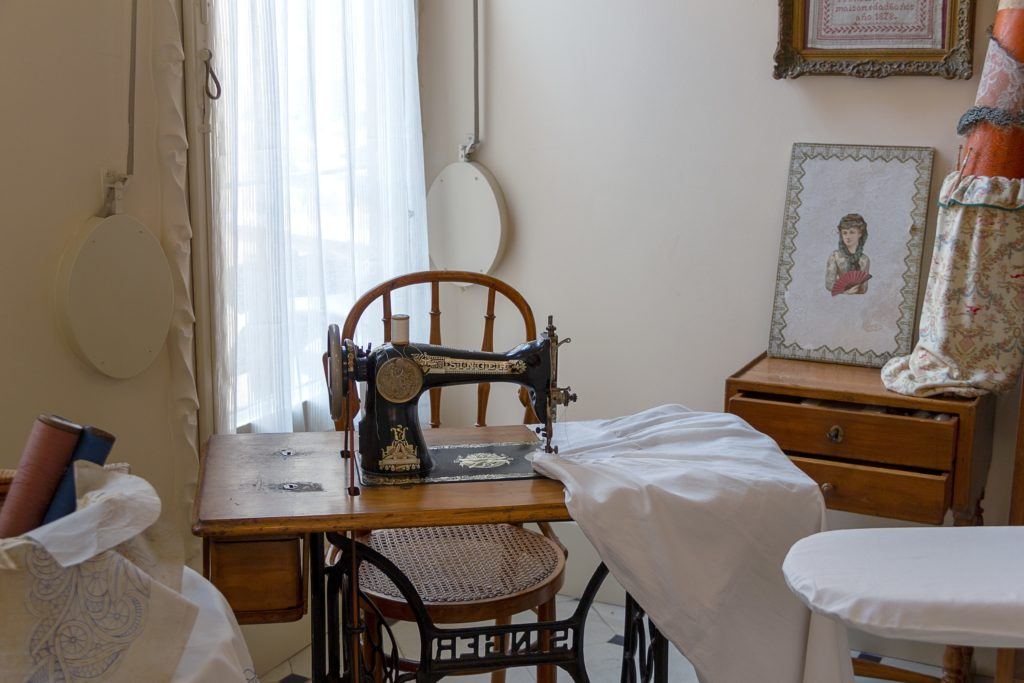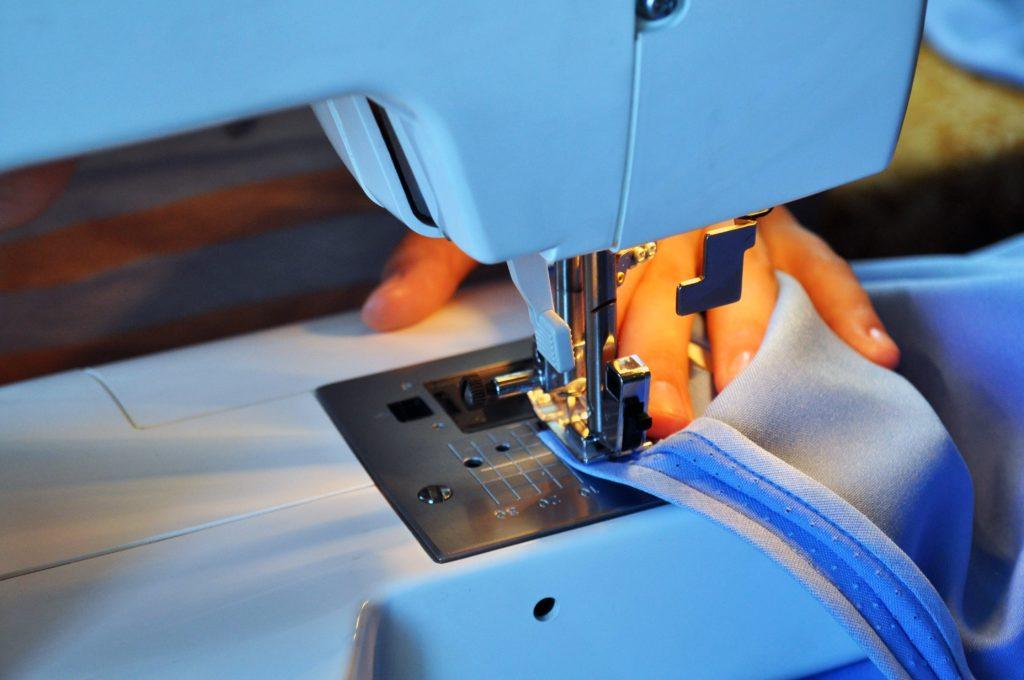Once you know where to look, harem pants are everywhere. In yoga studios, in Aladdin, on models and actors—harem pants are worn by pretty much everyone.
It’s not hard to understand why. These pants are both comfy and stylish, making them the perfect fashion statement for everyone, be it celebrities or someone headed out for a grocery run. Because of their design, creating your own spin on harem pants is fun and uncomplicated. Be it a longer waistline, an open cuff, or just extra bagginess, there’s a pair for everyone. What’s more, they’re super easy to develop all on your own. That makes them ideal for both beginners and experienced sewists alike.
Before we get into all of that, what exactly are harem pants? How did they come to be?
By the end, you’ll have patterns to work from, unique designs to try, and a better understanding of why these fashion statements belong in your wardrobe!
What Are Harem Pants?
Harem pants refer to a style that is both baggy and caught-in at the ankles. They are similar to hippy, Bohemian-style pants – only they tend to be less-form fitting, with a lower crotch-line. In the modern day, there are a few variations to the original harem pants. Such variations include openings in the outer seams, as well as different ways of closing the waistline and ankles.

History and Origin
Harem pants have a long and interesting history. Their origins can be traced as far back as 2,000 years ago, in the dhoti.
The dhoti is a traditional garment worn by men in India, Pakistan, Bangladesh, and Nepal. It was a rectangular piece of cloth that was wrapped around the waist, then the legs, and finally knotted and secured at the waist. The garment then resembled a long skirt from the front. From the back, however, it resembled baggy pants with a seam in the middle.
The first harem pants appeared in the western world in the 1800s; women’s rights activist Amelia Bloomer (who was responsible for another type of garment: bloomers), would introduce the garment as a way to represent feminism. The masculine connotations of trousers, as well as the formlessness of harem pants, became a symbol of women’s liberation.
However, harem pants wouldn’t catch on. Not until the 1900s, when French fashion designer Paul Poiret developed a clothing collection inspired by, in the day’s standards, exotic influences. He took inspiration from Oriental and Persian clothing, and redesigned them to become more appealing to his Western audience. His collection included kaftans, head dresses, tunics, and, of course, harem pants.
This clothing collection was decidedly more feminine than its original garment. They were made from satin and silk, and included embroidery and beading. The design was controversial in two parts; one was the taboo of Western women wearing trousers, another was the cultural appropriation of the Eastern style, marketed to be inappropriately sexual and exotic. But, like most trends, harem pants would eventually be passed on for other trends.
Modern Day Harem Pants
They would, however, make a comeback in the 80s – albeit in a more ‘costume’ than casual style. Harem pants also became more gender-neutral, rather than just feminine. They wouldn’t become hugely popular until 2009, when Ralph Lauren released his own take on harem pants and celebrities jumped on the new design.
Harem pants have come a long way from their controversial origins. In the modern day, they can be seen in many places, as casual wear to loud fashion statements on the runway. Their functional yet comfortable design has made them a staple in modern fashion, whether you’re wearing them for fashion, for comfort, or even both.
DIY Harem Pants
Creating your own harem pants is a great way to flex your sewing muscles. They’re the perfect pattern for those who are just beginning to branch out into other sewing projects. On top of that, harem pants can be easily altered so that you can have one for pretty much any occasion.
Where to Find Harem Pants Pattern
Like most designs, patterns for harem pants can be found both online and offline. You can find choices on blog posts, sewing websites, as well as in magazines.

However, because of their easy design, you can draft your own pattern in a number of ways. Here we’ll show two different ways of creating a pattern on your own. Both methods are great for any pair of harem pants, and you can simply choose the one that works best for you.
How to Make Harem Pants
The first method of creating a harem pants sewing pattern has a higher crotch line, making it look more like the pants you’d see in Aladdin. The second method has a lower crotch style, making it more Bohemian-style.
Method One
This first method is more form-fitting. It’s easier when compared to Method Two; however, it is best sewn with stretchy or knit fabrics. You can use non-stretchy fabric with the pant legs, but it may be harder to work with.
Regardless, you will need to use stretchy or knit fabric for the ankle belts.
Materials
- Knit fabric. (Measure the length of the waistband to the ankles, plus 8.5 inches; double this number to find your fabric length.)
- Coordinating thread.
- Elastic.
Procedure
- Cut out the pieces according to the dimensions recommended above.
- Begin assembling the two pant legs. Join the inseams (inner portion) of the top and bottom layers of each pant leg.
- Join the two pant legs by sewing along the crotch line.
- Join edges of the waist yoke, so that you create a tube. Once the edges are joined, finish the edges. Do this by turning your fabric toward the wrong side. Then turn the edges under the seam allowance, and stitch along the edge.
- Turn the inside of the waist yoke’s top edge 1 ½ inches inwards. Leave about an inch of opening for the elastic later.
- Gather the top edge of the pants. Do this by stitching two rows parallel to the edge, about ½-inch apart. Leave a long thread tail and pull it to gather. Keep gathering until the width of the edge is equal to the width of the waist yoke’s width.
- Place the waist yoke and leg piece on top of each other, right-sides facing. Join the edges.
- For the ankle belts, stitch the two raw edges of each ankle piece together, and stitch. Once stitched, fold the piece inside itself lengthwise, so that it’s now half its width.
- Attach the ankle belt to the bottom of the leg piece, right-sides together. The raw edges of the ankle belt and leg pieces should be lined up with each other. Join the edges.
- Measure out the elastic that you need by measuring out your waist and subtracting an inch. Add a half-inch seam allowance and insert the elastic into the waistband. Stitch the elastic edges together, and sew the opening closed.

Method Two
For those who would like a looser version of the pattern above, this method is perfect for you. The lower crotch line makes it suitable for harem pants that fit a belly-dancing costume. You can also be a bit more creative with this pattern and add side openings alongside the outer leg, since it has outer seams.
Unlike the first method, this choice is versatile and can use any type of fabric, not just knit fabric.
Materials
- Fabric of your choice. (Measure the length of the waistband to the ankles, plus 8.5 inches; double this number to find your fabric length.)
- Coordinating thread.
- Elastic, or ties for the ankles and waistline.
Procedure
- Cut your fabric pieces to size, using the dimensions recommended above. Using a ½ seam allowance, sew the outer seam of each leg. Press the seams open and finish the fabric edges with an overlock or zigzag stitch. If you want to leave the outer edges open, finish them with fabric trim.
- Stitch the inseam, then press the seams open. Press the seams open and finish the fabric edges with an overlock or zigzag stitch.
- Join the two pant leg pieces along the crotch line, with the pieces right-sides out. Stitch twice along the crotch line and press the seams open. Finish with an overlock or zigzag stitch.
- Make the waist and ankle casings. For the waist yoke, turn the fabric piece inwards at ½ inches, then at 1 ½ inches. Edge along the waistband, leaving a 1-inch opening. Insert the elastic and stitch the opening closed.
- Create the ankle belts similarly, by turning the piece inward at ½ inches, then 1 ½ inches.
You can create a few versions of this pattern by changing the waistline and the ankle hems.

You can develop the ankle hems with elastic, or you could secure them close with a button and hoop. As for the waistline, you can use a drawstring band to close the waistline, instead of elastic.
How to Make Baby Harem Pants
Harem pants are the perfect gift for any toddler. They’re not only simple to create, but they’re easy to move around in and super comfortable. As a bonus, harem pants are just the right kind of baggy to provide space for a diaper. This baby harem pants tutorial can be easily adjusted for any age. Check out the full baby harem pants pattern below.
Materials
- Main knit fabric, 16 x 24 inches.
- Contrast knit fabric, 10 x 18 inches.
- Matching sewing thread.
- Fabric pen or tailor’s chalk for marking.
Procedure
- Using your main fabric, cut out the front and back pieces of your harem pats.
- From the contrast knit fabric, cut the waistband and leg cuffs. For the waistband, cut out 4 ¾ x 16 ½ inches with the stretch on the long side. For the leg cuffs, cut two pieces measuring 4 ¾ x 7 1/8 inches with the stretch on the long side.
- Begin assembling your harem pants. Place the front and back pieces on top of each other, right-sides facing. Pin the outside legs and around the inside legs.
- Sew the pieces along the outside legs and inside the curved leg with 3/8-inch seam allowance.
- Turn the sewn piece inside out and press.
- For the cuffs, take one of the leg cuffs and fold in half, lengthwise, right-sides facing. Pin the two short ends together, so that it creates a fabric loop. Sew shut with 3/8-inch seam allowance.
- Finger press the seam open. Fold the loop in half, wrong sides together. Match the seams to create a double loop; it should measure 2 3/8 inches deep. Do the same for the other leg cuff, as well as the waistband.
- Take one of the cuffs and line up the raw edges to one of the pant legs’ raw edges. Lay the cuff seam against the inside leg seam. Pin all the way around, stretching the cuff to match the width of the pant leg. Sew together and tuck the seams under.
- Do the same for the other pant leg.
- Take the waistband and mark the quarter points with your fabric pen. Do the same with the top edges of your pants.
- Position the waistband like you did with the cuffs. Position the waistband seam in the center of the back of the pats.
- Pin together the waistband and top seam, making sure to match the quarter points. Stretch the waistband as you go to match the points.
- Stitch the waistband and top edge the same way as the cuffs.

Conclusion
Harem pants have a long and colorful history. In the modern-day, they are a garment worn for style and comfort, because of their casual and fun appearance. They’re great for almost any occasion, on anyone – even for babies!
Hopefully this guide has helped you create your own harem pants, whether you’re wearing them at home, or for your next belly dancing class.

